グルーピング構造分析ルール
Grouping rules
Strongly avoid groups containing a single event.
Avoid analyses with very small groups -- the smaller, the less preferable.
GPR1 は,どういうことかというと,
ひとつの音だけからなるグループを作るのは
避ける,ということですね.
alternative form のほうは,この条件を少し拡げて,
小さいグループを作るのは
避ける,ということですね.
「小さい」というのがどういう状況なのかが
本文にはいくつか書いてありますが,それについては,後日,書きます.
Consider a sequence of four notes n1, n2, n3, n4.
All else being eaual, the transition n2 - n3 may be heard as a group boundary if
a. (Slur/Rest) the interval of time from the end of n2 to the beginning of n3
is greater than
that from the end of n1 to the beginning of n2 and
that from the end of n3 to the beginning of n4, or if
b. (Attack-Point) the interval of time between the attack points of n2 and
n3 is greater than
that between the attack point of n1 and n2 and
that between the attack point of n3 and n4.
GPR2a (Slur/Rest) は,どういうことかというと,
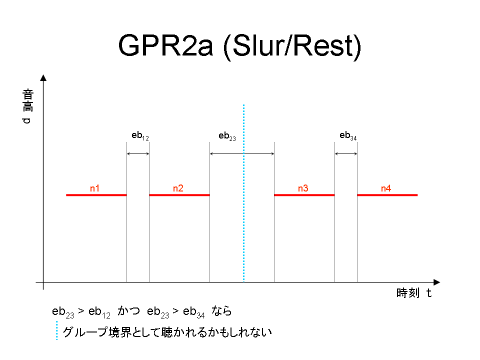 クリックすると拡大表示します.
クリックすると拡大表示します.
ということで,音イベントの終わりから次の音イベントの始まりまでの時間間隔
を比較して,
前後二つのそれよりも長ければ,そこはグループ境界として聴かれるかもしれないよ,
ということですね.
GPR2b (Attack-Point) は,どういうことかというと,
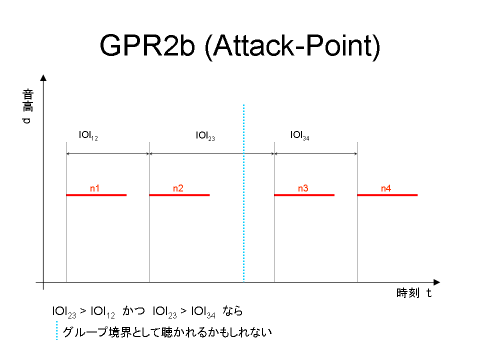 クリックすると拡大表示します.
クリックすると拡大表示します.
ということで,IOI (音イベントの始まりから次の音イベントの始まりまでの時間間隔)
を比較して,
前後二つのそれよりも長ければ,そこはグループ境界として聴かれるかもしれないよ,
ということですね.
Consider a sequence of four notes n1, n2, n3, n4.
All else being equal, the transition n2 - n3 may be heard as a group boundary if
a. (Register) the transition n2 - n3 involves a greater intervallic distance
than both n1 - n2 and n3 - n4, or if
b. (Dynamics) the transition n2 - n3 involves a change in dynamics and
n1 - n2 and n3 - n4 do not, or if
c. (Articulation) the transition n2 - n3 involves a change in articulation
and n1 - n2 and n3 - n4 do not, or if
d. (Length) n2 and n3 are of different lengths and both pairs n1, n2 and
n3, n4 do not differ in length.
GPR3a (Register) は,どういうことかというと,
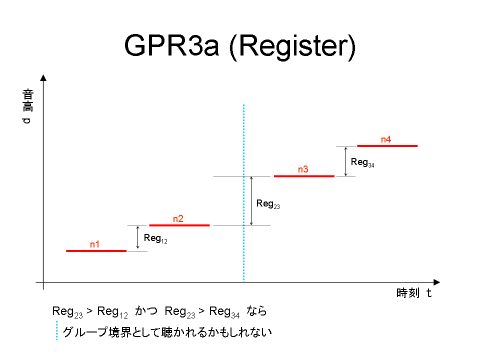 クリックすると拡大表示します.
クリックすると拡大表示します.
ということで,隣り合う二つのイベントの音程 (隣り合う二つのイベントの音高の差)
を比較して,
前後二つのそれよりも大きければ,そこはグループ境界として聴かれるかもしれないよ,
ということですね.
GPR3a (Dynamics) は,どういうことかというと,
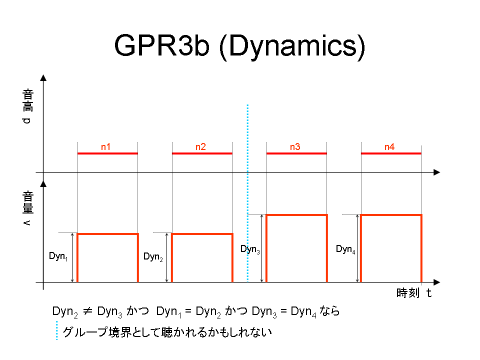 クリックすると拡大表示します.
クリックすると拡大表示します.
ということで,隣り合う二つのイベントの強弱
を比較して,
それの変化があるところの
前後二つのそれに変化がなければ,そこはグループ境界として聴かれるかもしれないよ,
ということですね.
原文では,p やf といった強弱記号について例示してあり,
この図にあるような Velocity 値のような値では比較していないですね.
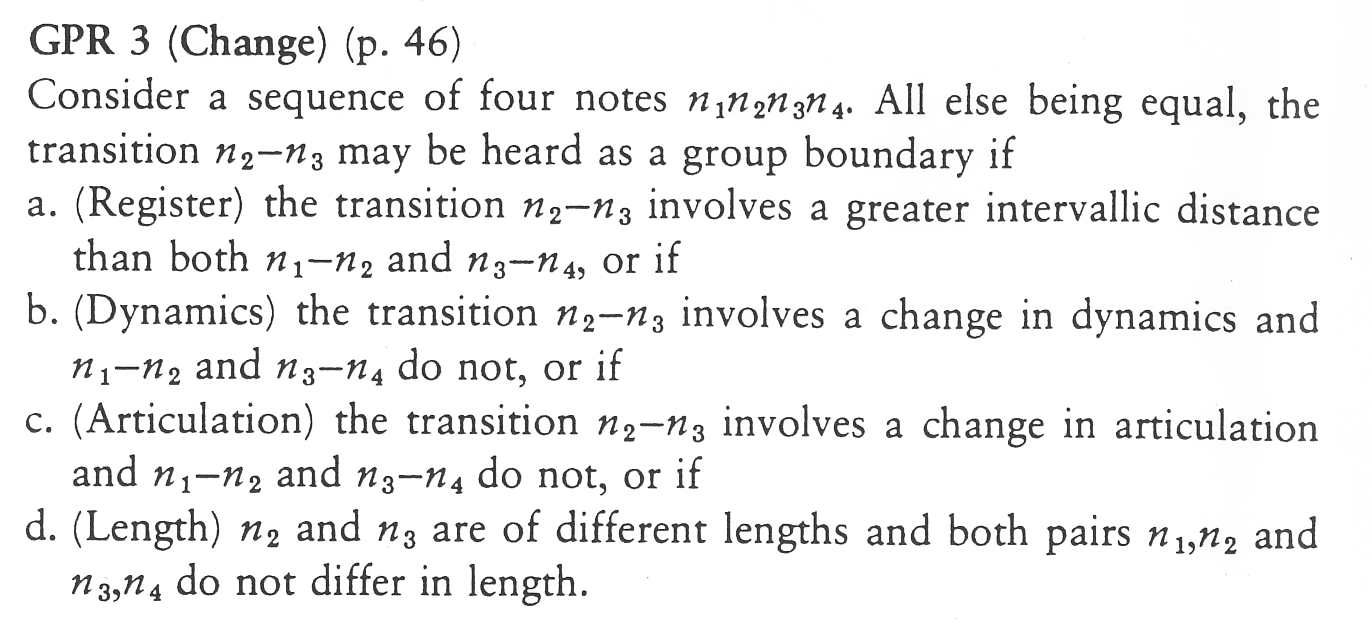
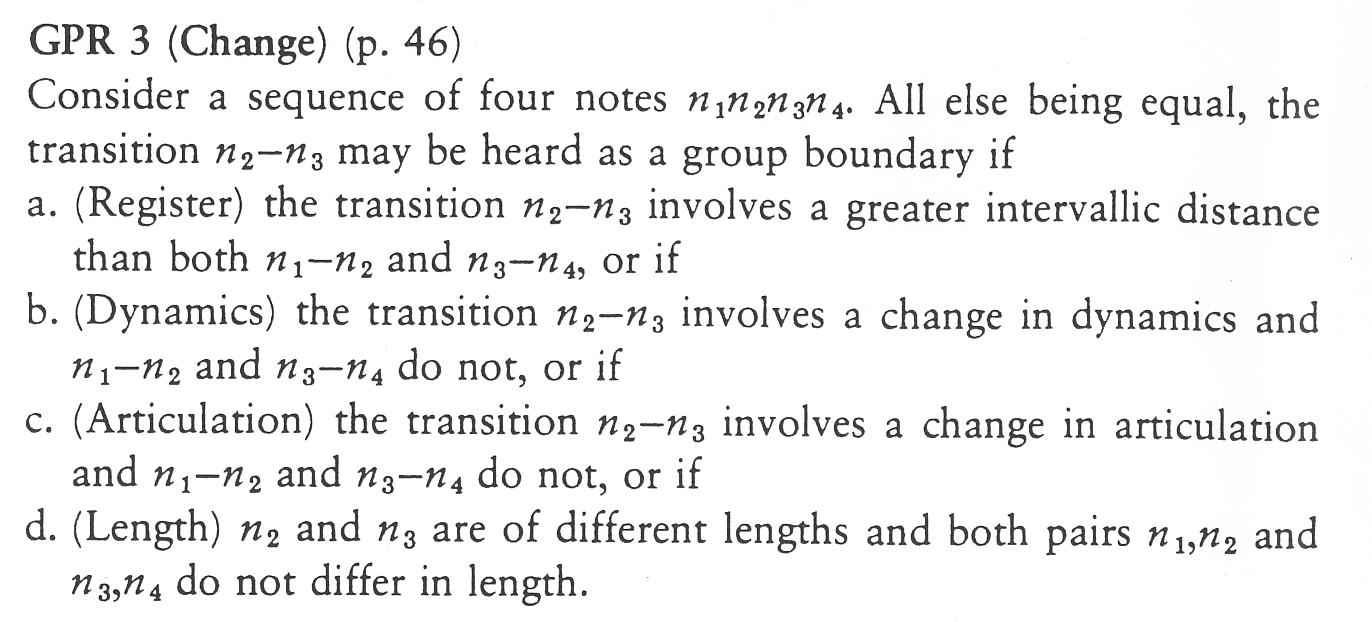


Where two or more segments of the music can be construed as parallel,
they preferably form parallel parts of groups.
二つ,あるいは,それ以上の音楽片に並列性があると解釈されるところで
グループの並列部分を形成する(グループを分割する)ことを選好する.
ご意見・ご感想・リンク希望などは
noike@kxa.biglobe.ne.jp
までメールで、または、
掲示板
まで、お気軽にどうぞ。
リンクを張ってくださる方は,このバナー
 http://www.noike.info/~kenzi/noike_bn.png
に
直接リンクをお張りください.
http://www.noike.info/~kenzi/noike_bn.png
に
直接リンクをお張りください.
 クリックすると拡大表示します.
クリックすると拡大表示します. クリックすると拡大表示します.
クリックすると拡大表示します. クリックすると拡大表示します.
クリックすると拡大表示します. クリックすると拡大表示します.
クリックすると拡大表示します.



 http://www.noike.info/~kenzi/noike_bn.png
に
直接リンクをお張りください.
http://www.noike.info/~kenzi/noike_bn.png
に
直接リンクをお張りください.